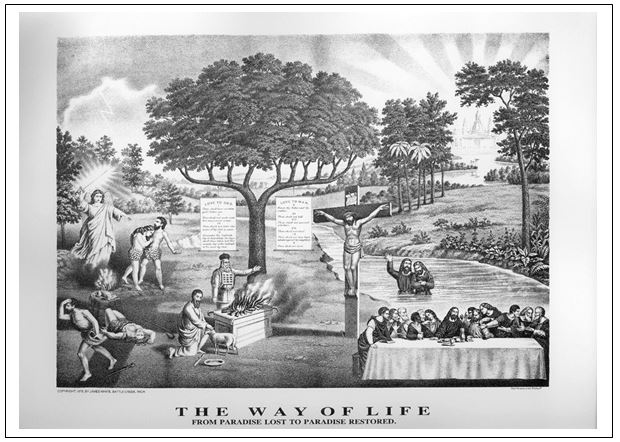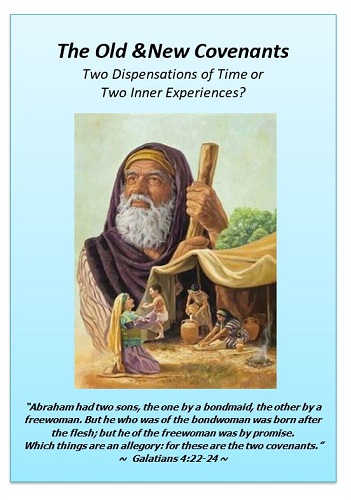26. Growing on the Solid Platform
[1]
A. Pioneers Given Great Light Concerning Person of Christ
Ellen White describes the Adventists experience as one that was lead step by step onto a solid immovable platform.
I was again brought down through these messages, and saw how dearly the people of God had purchased their experience. It had been obtained through much suffering and severe conflict. God had led them along step by step, until He had placed them upon a solid, immovable platform. EW 259 (1882)
In another place Ellen recalls the intense study and prayer that took place to understand the truth.
“After the passing of the time in 1844 we searched for the truth as for hidden treasure. I met with the brethren, and we studied and prayed earnestly. Often we remained together until late at night, and sometimes through the entire night, praying for light and studying the Word. Again and again these brethren came together to study the Bible, in order that they might know its meaning, and be prepared to teach it with power. When they came to the point in their study where they said, "We can do nothing more," the Spirit of the Lord would come upon me. I would be taken off in vision, and a clear explanation of the passages we had been studying would be given me, with instruction as to how we were to labor and teach effectively. Thus light was given that helped us to understand the Scriptures in regard to Christ, his mission, and his priesthood. A line of truth extending from that time to the time when we shall enter the city of God, was made plain to me, and I gave to others the instruction that the Lord had given me.” RH, May 25, 1905 par. 24
If we notice carefully, Ellen White clearly recalls that light was given regarding Christ, His mission and His priesthood. The line of truth that they received regarding Christ would extend right through to the city of God. There were several teachings[2] that were searched out into an interlocking system of truth. Part of that interlocking system was truth about the person of Christ and that truth was integrally locked into an understanding of the plan of salvation.
B. If Pioneer View of Christ was Essentially Flawed, the Whole System is Flawed
The Bible clearly teaches that no other foundation can be laid than Jesus Christ (1 Cor 3:11) If Adventism built an interlocking system of beliefs upon a view of Christ that was essentially incorrect, then the foundation is wrong and the entire system is wrong. This point can not be sidelined or overlooked.
IF THE FOUNDATION WAS WRONG CONCERNING CHRIST THEN
THE ENTIRE SYSTEM WAS AND IS WRONG
Christ is the centre and circumference of all truth.[3] If that view hammered out by our pioneers gave a view of Christ that was essentially not who He was then the whole system is infected by the wrong framework. The entire system must be re-laid, renovated and changed. A new order of books would need to be written, a new system of education would need to be engaged to recover from such a tragic mistake.
C. Literal Sanctuary Mandates Literal Son of God
One of the key elements of the Adventist Sanctuary Message was the connection between the literalness of the personalities of Father and Son and the literalness of the Sanctuary. James White expressed it thus:
The Most Holy, containing the Ark of the ten commandments, was then opened for our Great High Priest to enter to make atonement for the cleansing of the Sanctuary. If we take the liberty to say there is not a literal Ark, containing the ten commandments in heaven, we may go only a step further and deny the literal City, and the literal Son of God. Certainly, Adventists should not choose the spiritual view, rather than the one we have presented. We see no middle ground to be taken.[4]
“Here is positive testimony that there is a tabernacle which the Lord pitched and not man, and that this tabernacle is in the heavens, (not heaven itself,) and that of this sanctuary, Christ is the minister. That there are literal things in heaven the Scriptures abundantly testify. As the great offering for the world, made on Calvary was literal, and as our great High Priest, Jesus, the son of God, is a real and literal personage, so must he have a literal sanctuary in heaven, in which to perform his priestly office.”[5]
Says the prophet Daniel, "I beheld till the thrones were cast down, and the Ancient of days did sit, whose garment was white as snow, and the hairs of his head like the pure wool; his throne was like the fiery flame, and his wheels as burning fire." Chap.vii,9. "I saw in the night visions, and, behold, one like the Son of man came with the clouds of heaven, and came to the Ancient of days, and they brought him near before him, and there was given him dominion and glory and a kingdom." Verses 13, 14.
Here is a sublime description of the action of two personages; viz, God the Father, and his Son Jesus Christ. Deny their personality, and there is not a distinct idea in these quotations from Daniel. In connection with this quotation read the apostle's declaration that the Son was in the express image of his Father's person. "God, who at sundry times, and in divers manners, spake in time past unto the fathers by the prophets, hath in these last days spoken unto us by his Son, whom he hath appointed heir of all things, by whom also he made the worlds; who being the brightness of his glory, and the express image of his person." Heb.i,1-3. The Personality of God Page 3 and 4[6]
James White states emphatically that there is no middle ground on this issue. The system of Adventism, its sanctuary and priestly system hang upon a literal understanding rather than a spiritual view. Ellen White States it this way:
“Those who seek to remove the old landmarks are not holding fast; they are not remembering how they have received and heard. Those who try to bring in theories that would remove the pillars of our faith concerning the sanctuary or concerning the personality of God or of Christ, are working as blind men. They are seeking to bring in uncertainties and to set the people of God adrift without an anchor.” MR760 9.5
Taking our Bibles as they read, the sanctuary teaching reveals two literal personages operating in the Sanctuary; the Father and the Son. This is clearly revealed in Daniel 7.
Dan 7:9 I beheld till the thrones were cast down, and the Ancient of days did sit, whose garment was white as snow, and the hair of his head like the pure wool: his throne was like the fiery flame, and his wheels as burning fire.
Dan 7:13 I saw in the night visions, and, behold, one like the Son of man came with the clouds of heaven, and came to the Ancient of days, and they brought him near before him.
In verse 9, the Father is described in the throne. In verse 13, the Son is brought to the Father in the Most Holy Place. Note the sequence Ellen White portrays in Early Writings describing the events of Daniel 7
I saw a throne, and on it sat the Father and the Son. I gazed on Jesus' countenance and admired His lovely person. The Father's person I could not behold, for a cloud of glorious light covered Him. I asked Jesus if His Father had a form like Himself. He said He had, but I could not behold it, for said He, "If you should once behold the glory of His person, you would cease to exist." EW Page 54
Under the title “End of the 2300 days” Ellen White pictures Father and Son seated on a throne and then she raises a question regarding the person of the Father. Jesus tells Ellen that the Father has a form like himself. The reality of the Father and Son personages is reinforced before moving on. Further down we read
I saw the Father rise from the throne, and in a flaming chariot go into the holy of holies within the veil, and sit down. EW 55
And thirdly we read
Then Jesus rose up from the throne, and the most of those who were bowed down arose with Him. I did not see one ray of light pass from Jesus to the careless multitude after He arose, and they were left in perfect darkness. Those who arose when Jesus did, kept their eyes fixed on Him as He left the throne and led them out a little way. Then He raised His right arm, and we heard His lovely voice saying, "Wait here; I am going to My Father to receive the kingdom; keep your garments spotless, and in a little while I will return from the wedding and receive you to Myself." Then a cloudy chariot, with wheels like flaming fire, surrounded by angels, came to where Jesus was. He stepped into the chariot and was borne to the holiest, where the Father sat. There I beheld Jesus, a great High Priest, standing before the Father. EW 55
In describing the events of the end of the 2300 days;
- Father and Son are seating together on a Throne in the Holy Place
- The Father rides a chariot into the Most Holy Place and sits down
- The Son is brought on a chariot into the presence of the Father in the Most Holy Place.
These are real and literal events. We also note in this transaction the interaction of two personal beings. The Sanctuary presents two personal beings acting in the plan of salvation. It is certain that the Holy Spirit is revealed everywhere in the Sanctuary (in the fire, the water, the oil etc) but he is not revealed as a separate and distinct personal being. The question that must be asked is where do we see a three person (co-equal co-eternal) Trinity in the Sanctuary? You will find it nowhere.
This being the case, a shift from a literal Father and Son to a metaphorical representation of Father and Son will open the door to negate the literalness of the events of Daniel 7 and the Judgment. This door has been opened by Adventist theologians. At every time in my theological training, I was advised that the events of the investigative judgment were symbolic. It was suggested to me that God cannot be cooped up in a “box” for 150 years because God inhabits the whole universe. It was suggested the Sanctuary is not a literal building but rather a symbol of the two phases of Christ’s ministry. It was suggested to me that God does not need to examine literal books because God already knows everything and already knows who are His and who are not. In essence, the end of the 2300 days is a stage show for the universe – it is not real.
D. Growing in our Understanding of the Godhead
It has been suggested in several places that Seventh-day Adventists grew in their understanding of the Godhead and that in the refinement process we were led to an understanding of a co-equal and co-eternal Trinity. Examples are used in terms of the development of the Sabbath start and end times, the health message and the tithing system. All of these are indeed examples of refinement of a principle, but it can never be stated that a change in the view that Christ was indeed the Son of God literally can be refined into a view that Christ is not the Son of God in identity but only in function. This is a complete shift that cannot be simply categorised as a refining process.
In the book “The Trinity” by Whidden, Moon and Reeve it is suggested on page 181 that Adventism went through a process of anti-Trinitarianism in order to jettison the Greek philosophical basis of the Trinity that other Church communions included. This suggestion overlooks the fact that the entire movement would have been placed of a false platform in the process; a process that would infect every other doctrine. If the Lord wanted to remove the Greek philosophical platform and retain the Trinity purely on “Biblical grounds” I am sure it could have been done without dragging the name of Christ through a completely false view and laying a completely false foundation.
|
|
E. Pioneer View of Christ Did Need Refinement as Evidenced by 1888 Message
One thing that is evident and that is the pioneer position of the Godhead certainly needed refining. If it did not then the 1888 message would not need to have been given. Non-Trinitarians make a mistake if they say that we should believe exactly as the pioneers did. Such a statement could indicate a negation of the need for the 1888 message and a fuller view of the role and Deity of Christ.
My assessment is that while pioneers were correct to assert that Christ was the literal Son of God, their understanding of how central and how far reaching Christ is to every teaching of the Bible needed time to expand and be realised. The message of 1888 lifted Christ into a much more central position from which all truth radiates. It also clarified the process of keeping the commandments of God though the grace of Christ. This lack of refinement in understanding sometimes subtly and unwittingly downgraded the role of Christ. The shift in the 1888 message was that Christ was presented in all the fullness of the Godhead more clearly and in a more refined way. It was old light placed it is correct context. Probably the simplest way to show this unwitting downgrade is in the contrast of two pictures endorsed by James and Ellen White. Notice the picture that James endorsed called the “Way of Life”
|
|
In the above picture, we see all the key elements of the plan of salvation, the fall and the curse, the sacrifice and priesthood, the law and the incarnation and sacrifice of Christ and the founding of the Christian church that culminates in the celestial city. This picture certainly contains all the essential elements but the emphasis is quite different from the picture Ellen White Endorsed. The way that the law is presented and emphasised reflected a view of some pioneers of our efforts to keep the law of God. Notice the following:
“In the early years of this message the laborers had one specific objective - to herald to the world the great fact that the last proclamation of the advent of Christ, to be given previous to his appearing in the clouds of heaven, is now going to the world, and to lead souls to Christ through obedience to this closing testing truth. This was the one objective point of all their efforts; and the end sought was not considered gained unless souls were converted to God, and led to seek through an enlightened obedience to all his commandments, a preparation for the Lord from Heaven” [7]
The above statement by Uriah Smith lacks refinement in expressing the principles of how obedience occurs. The emphasis is heavy on obedience and limited on grace. The very phrase “coming to Christ through obedience…” appears to completely negate the centrality of the gospel. Notice another example written in the Review and Herald curiously titled “Justified by Works”
“We have seen that to repent is .. to feel such sorrow for sin as to lead one to turn from it, and seek forgiveness. Then when Jesus and the apostles told the people that they must repent before they could believe or be converted, they must feel such sorrow for sin as would lead them to turn from it, and seek forgiveness, or, in other words, they must stop sinning before they could receive pardon or be justified…
Let me say again, reader, do not get the idea that I am trying to lessen your obligation to believe in Christ. Let me define my position once more. To make satisfaction for past sins, faith is everything. Precious indeed is that blood that blots out all our sins, and makes a clean record of the past. Faith only can make the promises of God our own. But present duty is ours to perform. When God says, "To-day if ye hear his voice, harden not your heart," all depends upon how we hear. Justification or condemnation is ours to choose. Obey the voice of God and live, or disobey and die. The choice is ours to make. We have it in our own power to live or die.” [8]
The above statement is shocking in its strident tones of obedience. There is nothing of the saving power of Christ enabling us to obey and a complete reliance on Christ for Grace to overcome. Such statements clearly indicate a lack of understanding of the work of Christ in the plan of salvation. I contend that while the personality of Father and Son were basically understood, the significance of the work of Christ in Adventist Doctrine was still being confused by the lie of the serpent. The emphasis on works and obedience revealed a confused belief that man had some kind of personal power to keep the commandments of God that was aided by the work of Christ. This sentiment had to be changed or Adventism would be completely destroyed. This is why Ellen White wrote:
“The Lord in His great mercy sent a most precious message to His people through Elders Waggoner and Jones. This message was to bring more prominently before the world the uplifted Saviour, the sacrifice for the sins of the whole world. It presented justification through faith in the Surety; it invited the people to receive the righteousness of Christ, which is made manifest in obedience to all the commandments of God. Many had lost sight of Jesus. They needed to have their eyes directed to His divine person, His merits, and His changeless love for the human family. All power is given into His hands, that He may dispense rich gifts unto men, imparting the priceless gift of His own righteousness to the helpless human agent. This is the message that God commanded to be given to the world. It is the third angel's message, which is to be proclaimed with a loud voice, and attended with the outpouring of His Spirit in a large measure.” TM 91, 92
|
|
In Ellen White’s picture endorsed in 1883 we see even in the title a deeper recognition of the central role that Christ plays in the way of salvation. The cross of Christ towers above all other scenes along the way. The law is symbolised in the experience of Mt Sinai with the flashing lightning rather than the written code hanging upon the tree. Such a shift emphasises the living reality of Christ in you the hope of glory, rather than the acknowledgment of a written code. The shift in the picture emphasises a growing and refining awareness of the centrality of the person of Christ as the Way, the Truth and the Life. All of these principles exploded into Adventist consciousness in the 1888 message. The 1888 message shifted our view of Christ and also ourselves that all power to obey comes through Christ and we are totally helpless with it.
F. Trinity Complete Reversal Not Refinement of Pioneer Platform
It would seem natural for those who view the equality of Christ in intrinsic terms rather than inherited terms could view the shift of emphasis on the role Christ in an expanded Deity as the beginning of a shift to Trinitarianism. Such a view though, must ignore the platform that Adventism was laid upon and it must be called a complete reversal on the person of Christ, not simply a refinement.[9] Such leaps in logic are easy to understand in light of the urgency with which Adventism has struggled to embrace the relational view of the centrality of Christ and also the growing desire[10] to avoid the cult label from other Protestants.
Ellen White was quite clear that Jones and Waggoner presented Christ in all the fullness of the Godhead.
“Messages bearing divine credentials have been sent to God’s people; the glory, the majesty, the righteousness of Christ, full of goodness and truth, have been presented; the fullness of the Godhead in Jesus Christ has been set forth among us with beauty and loveliness, to charm all whose hearts were not closed to prejudice. We know that God has wrought among us.” EGW 1888 materials page 673
If it is THE FULNESS then I think we can accept that IT WAS THE FULLNESS. Yet it is clearly evident to any candid student that Jones and Waggoner did not present Christ as the Co-Equal and Co-eternal God but rather the Son of God. The facts are there if we want to see them. Knowing that these messengers presented this view of the Godhead we must consider carefully this next quote.
The time of test is just upon us, for the loud cry of the third angel has already begun in the revelation of the righteousness of Christ, the sin-pardoning Redeemer. This is the beginning of the light of the angel whose glory shall fill the whole earth. For it is the work of every one to whom the message of warning has come, to lift up Jesus, to present him to the world as revealed in types, as shadowed in symbols, as manifested in the revelations of the prophets, as unveiled in the lessons given to his disciples and in the wonderful miracles wrought for the sons of men. Search the Scriptures; for they are they that testify of him. {RH, November 22, 1892 par. 7}
This who reject the idea of Jesus being begotten of the Father and receiving His inheritance need to explain how such an erroneous view can be connected the Loud Cry of Revelation 18? If Jesus is the Truth (John 14:6) and Revelation 18 is a mighty revelation of truth, how can there be a mighty revelation of truth when the chief messengers have a wrong view of who Jesus is?
Holding a position that Christ came forth from the Father has sadly led some Adventists to accuse such believers as Catholic because the Catholic doctrine of the Trinity holds that Christ is both Co-eternal and Begotten at the same time, a devilish dialectic dilemma indeed! The point I would make is that to say someone holds a Catholic view because they believe Christ is brought forth from the Father is to suggest that our pioneers placed the platform of Adventism squarely upon a Catholic base. The absurdity of this need not be documented or expressed further.
I mentioned earlier that if the position hammered out by our pioneers gave a view of Christ that was essentially not who He was then the whole system is infected by the wrong framework. The entire system must be re-laid, renovated and changed. A new order of books would need to be written, a new system of education would need to be engaged to recover from such a tragic mistake.
The question is what has been taking place in Adventism? Exactly the above! A new order of books that downplay the literal sanctuary, shifts on justification and sanctification, shift on the nature of Christ, shifts on the investigative judgement, shifts on Christian perfection, shifts on the role of the Spirit of Prophecy, shifts on the roles of men and women. This onward march of shifting and switching at such a scale does clearly indicate that either the pioneers did lay the foundations incorrectly or the current church has stepped off the original platform. As James White expressed it “There is no middle ground”
Ellen White speaks directly to this issue when she states:
History is repeating. With the open Bible before them, and professing to reverence its teachings, many of the religious leaders of our time are destroying faith in it as the word of God. They busy themselves with dissecting the word, and set their own opinions above its plainest statements. In their hands God's word loses its regenerating power. This is why infidelity runs riot, and iniquity is rife.
When Satan has undermined faith in the Bible, he directs men to other sources for light and power. Thus he insinuates himself. Those who turn from the plain teaching of Scripture and the convicting power of God's Holy Spirit are inviting the control of demons. Criticism and speculation concerning the Scriptures have opened the way for spiritism and theosophy--those modernized forms of ancient heathenism--to gain a foothold even in the professed churches of our Lord Jesus Christ.
Side by side with the preaching of the gospel, agencies are at work which are but the medium of lying spirits. Many a man tampers with these merely from curiosity, but seeing evidence of the working of a more than human power, he is lured on and on, until he is controlled by a will stronger than his own. He cannot escape from its mysterious power. DA 258
[1] This chapter is an expansion of appendix E and F and has been included partly for the fact that appendices are often overlooked and not fully considered.
[2] See CW 30 for a description of old landmarks and pillar doctrines.
[3] RH August 15, 1893
[4] J. S. White, The Parable, p. 16
[5] RH, 18-8-1863
[6] The full tract by James White is found in Appendix H
[7] Uriah Smith, Review and Herald Jan 3, 1888 Page 8.
[8] J. F Ballenger, Review and Herald, Oct 20 1891 Page 642
[9] Clear evidence for the complete inability for the Trinity to be a refinement of the Pioneer doctrine is the insightful article by George Knight that appeared in Ministry Magazine in Oct 1993. He states that very few Pioneers would be able to join the church today before of current views on the Godhead. This is clear evidence that this is not refinement but a complete change. A refinement would still allow our pioneers to join the church.
[10] This growing desire for unity with other Protestants was strengthened by the threatening rise of higher criticism in protestant circles and the consequent fundamentalist reaction on the 1920’s. Adventism in some ways was forced to choose sides. As George W. Bush expressed it “either you are with us or you are with the terrorists” (Higher Critics)








